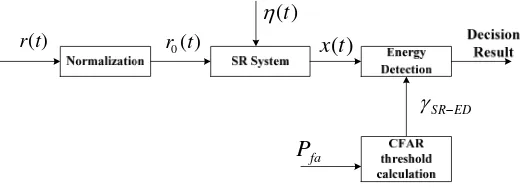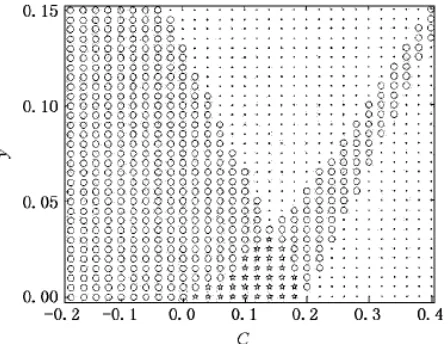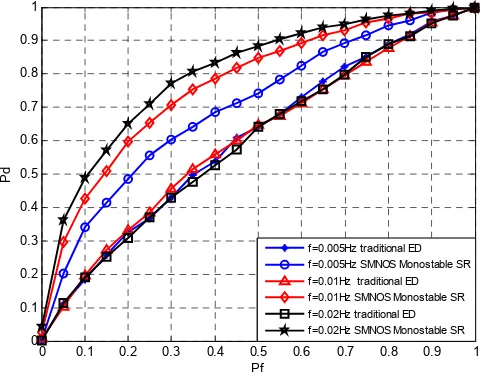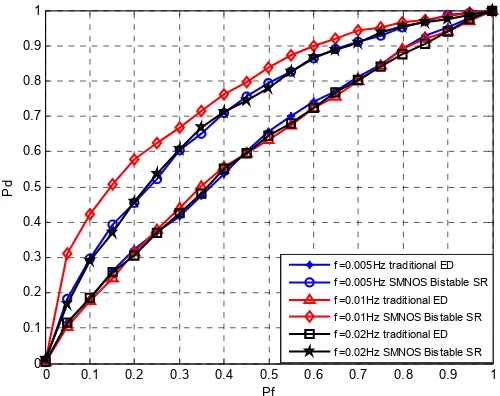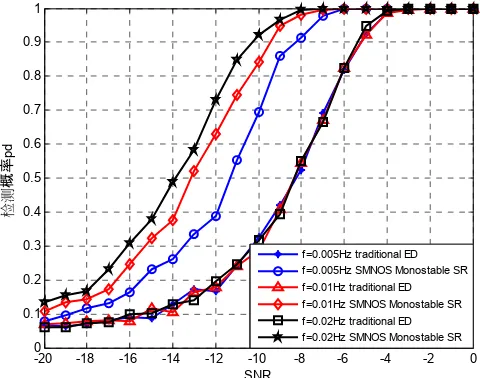DOI: 10.12928/TELKOMNIKA.v13i2.1431 494
Application of Stochastic Resonance of The
Single-Mode Nonlinear Optical System in Spectrum
Sensing of Cognitive Radio Networks
Yonghua Wang1,2,3, Pin Wan2, 4*, Qin Deng2, Yuli Fu1 1
School of Electronic and Information Engineering, South China University of Technology, Guangzhou 510641, Guangdong, China
2
School of Automation, Guangdong University of Technology, Guangzhou 510006, Guangdong, China 3
Hubei Key Laboratory of Intelligent Wireless Communications, South-Central University for Nationalities, Wuhan430074, Hubei, China
4
National Engineering Research Center for Mobile Communication, Guangzhou 510310, Guangdong, China
*Corresponding author, e-mail: wanpin3@ sohu. com
Abstract
The cognitive radio technology can improve the efficiency of spectrum utilization byproviding dynamic spectrum access to unoccupied frequency bands. Spectrum sensing is one of the key technologies of cognitive radio networks. The spectrum sensing performance of cognitive radio networks will be greatly reduced in the low SNR environment, especially when using energy detection. Because the stochastic resonance system can improve the energy detection system output SNR .To improve the spectrum sensing performance of cognitive radio networks in the low SNR environment, the stochastic resonance of the single-mode nonlinear optical system is applied to spectrum sensing based on the energy detection method in this paper. The simulation results show that in the low SNR environment, the energy detection based on stochastic resonance of the single-mode nonlinear optical system has better performance than traditional energy detection.
Keywords: Stochastic Resonance, Single-mode Nonlinear Optical System, Cognitive Radio Networks, Spectrum Sensing, Energy Detection
1. Introduction
The Cognitive radio technology can improve the efficiency of spectrum utilization by providing dynamic spectrum access to unoccupied frequency bands.One of the biggest challenges for spectrum sensing (SS) of cognitive radio (CR) networks is detecting the weak primary user (PU) signal in low SNR environment [1]. In low SNR environment, the performance of spectrum sensing will be greatly reduced [2]-[3]. In recent years, some researchers have proposed the application of stochastic resonance (SR) to spectrum sensing in order to solve the problem of detecting weak signal of the primary user. Stochastic resonance refers to the noise energy will be transferred to the signal energy when the input signal and the noise have a match in the non-linear system [4]. At this time, the SNR of the input signal will not be lowered, but will increase. Therefore stochastic resonance is ideal for weak signal detection problem. Stochastic resonance system consists of three elements: a monostable or bistable or multistable nonlinear system, input signal and noise.
The present researches on spectrum sensing based on stochastic resonance are all based on traditional bistable stochastic resonance, and the nontraditional stochastic resonance is not involved. Due to stochastic resonance systemof the single-mode nonlinear optical system can improve the output SNR; it is applied to spectrum sensing based on the energy detection method of Cognitive Radio (CR) networks in order to improve the performance of the energy detection under low SNR in this paper.
2. The Application of nonlinear single-mode optical stochastic resonance system in the energy detection
2.1. Energy detection
Because the energy detection has the following advantages: need not to know any prior knowledgeof the primary users (PU), low computational complexity and easy implementation, thus it is widely used in the cognitive radio spectrum sensing. According to the Neyman-Pearson criteria, spectrum sensing problem can be formulated as the following two assumptions: the received signal of the SU.s t( )is the PU signal and is assumedwith zero mean and variance
2 n
.n t( )denotes the Gaussian noise and is assumed to be an i.i.dGaussian random process with zero mean and variance 2
n
.The signal s t( ) and the noise n t( ) are assumed independent of each other.
The energy detection model based on stochastic resonance is shown in Figure 1 [4].
)
Figure 1. The energy detection model based on stochastic resonance
2.2. The nonlinear single-mode optical system
Ref. [16] studied the behavior of a single-mode stochastic resonance nonlinear optical systems using linear response theory. Based on this research, Wan PIN further studied the stochastic resonance phenomenon of SNR gain in such a single-mode nonlinear optical system (SMNOS), and verified through simulation:in the case of the signal and the noise input at the same time, the system SNR can reach a higher value [17]. The single-mode nonlinear optical system is applied to the energy detection of cognitive radio system to enhance the detection performance of the conventional energy detector in this paper.The phenomenological kinetics equation of single-mode nonlinear optical system with six potential functions is:
Where Cis the system parameter,yis dimensionless incident light field,x is dimensionless outgoing light field,n t( ) is the introduced Gaussian white noise, and satisfiesE n t[ ( )]0,E n t n t[ ( ) ( )]2D(t),where D is the noise intensity. With the change of parameters ofCand y, the system defined by formula (2) will be in the monostable, bistable and tristable state respectively, the specific distribution as shown in Figure 2. According to the literature [16], whenC are 0.3, -0.1, and 0.1, the system will in the monostable, bistable, tristable steady staterespectively.
Figure 2. The distribution of the stable fixed point on parameter plane (·Monostable, ○Bistable, ☆Tristable)
3. Experimental Procedure
Detection performance is discussed in the situation that under different false alarm probabilities condition while same SNR, and in the situation that under different SNR while same false alarmprobability. The Monte Carlo method is used, specific steps are as follows:
3.1. Different false alarm probabilities while same SNR
(1) According to binary hypothesis, the received signal is divided into two cases: H0and
1
H . The received signal is performed N-point sampling, and then processed by stochastic resonance system.
(2) According to the energy detection principle, received signal energy valuesE0 and E1in two hypothetical scenarioswere calculated,then the n cyclescalculations are carried out.
(3) After n cycles of calculations, the resultingE0 and E1 will be stored in the array
01 02 03 0
[ , , , , n]
a E E E E and b E[ 11,E12,E13,,E1n].Then array a E[ 01,E02,E03,,E0n] is arranged in ascending order, and be saved to another array [ ,1 2, 3,,n]as threshold values.
(4) Calculate the numbers that the elements in the arraya E[ 01,E02,E03,,E0n] greater than the threshold value 1, 2, 3,,n respectively, then obtainedL L L L[ 1, 2, 3,,Ln] .
1 2 3
[L / ,n L / ,n L / ,n,Ln / ]n represents a set of false alarm probabilityP Pfa[ fa1,Pfa2,Pfa3,,Pfa n],where Pfa[0,1].
(5) Calculate the numbers that the elements in the arrayb E[ 11,E12,E13,,E1n] greater than the threshold value 1, 2, 3,,n respectively, then obtainedM M M M[ 1, 2, 3,,Mn] .
1, 2, 3, , d d d d n
P P P P represent the detection performance when false alarm probabilities are
1, 2, 3, , fa fa fa fa n
P P P P under the same SNR environment.
3.2. Constant false alarm probability under different SNR environment Steps (1), (2), (3) and (4) are same as above.
(5) Under the condition of constant false-alarm probability, the subscript of in the array [ ,1 2, 3,,n]is represented by.uis the corresponding energy detection threshold in a given false-alarm probability. After n times calculations, the resulting energy values E1 are saved to arrayb E[ 11,E12,E13,,E1n].Then the number M that the elements ofb E[ 11,E12,E13,,E1n] greater than u is calculated.M n/ is the detection probability Pd.
(6) Repeat steps (1) to (5) different SNR environments, the detection probabilities can be obtained under the environments with constant false alarm probability and different SNR.
4. Simulation results
Experimental procedures as previously described. In this paper, without considering channel fading and co-channel interference, parameter settings are as follows:the primary user signal isAcos(2 ft), Gaussian white noise is n t( ),the bistable
, Signal frequency f are 0.005 Hz,0.01 Hz,0.02Hz respectively, sampling frequency fs 128f ,sampling point N=256, Monte Carlo simulation times is 1000. Compare the traditional energy detection method and energy detection method based onsingle-modenonlinear optical system performanceunder two conditions that at the same SNR different false alarm probability environment or constant false alarm probability different SNR environment. The results are shown in Figures 3-8.
0 0.1 0.2 0.3 0.4 0.5 0.6 0.7 0.8 0.9 1
0 0.1 0.2 0.3 0.4 0.5 0.6 0.7 0.8 0.9 1 0
0.1 0.2 0.3 0.4 0.5 0.6 0.7 0.8 0.9 1
Pf
Pd
f=0.005Hz traditional ED f=0.005Hz SMNOS Bistable SR f=0.01Hz traditional ED f=0.01Hz SMNOS Bistable SR f=0.02Hz traditional ED f=0.02Hz SMNOS Bistable SR
Figure 4. ROC curves of SMNOS bistable SR and traditional ED under SNR=-15Db
Figures 3, 4 and 5 are ROC curves of traditional energy detection and the monostable, bistable and tristable stochastic resonance energy detection of the single-mode nonlinear optical system respectively when the SNR is -15dB.As can be seen from the figures, under various false alarm probability cases, the traditional energy detection performance is not affected by the signal frequency. But the energy detection based on single-mode nonlinear optical system stochastic resonance has different performance with different signal frequencies. And the detection performance of energy detection based on monostable, bistable and tristable system are superior to traditional energy detection.
0 0.1 0.2 0.3 0.4 0.5 0.6 0.7 0.8 0.9 1 0
0.1 0.2 0.3 0.4 0.5 0.6 0.7 0.8 0.9 1
Pf
Pd
f=0.005Hz traditional ED f=0.005Hz SMNOS Tristable SR f=0.01Hz traditional ED f=0.01Hz SMNOS Tristable SR f=0.02Hz traditional ED f=0.02Hz SMNOS Tristable SR
-20 -18 -16 -14 -12 -10 -8 -6 -4 -2 0 0
0.1 0.2 0.3 0.4 0.5 0.6 0.7 0.8 0.9 1
SNR
概率
检测
pd
f=0.005Hz traditional ED f=0.005Hz SMNOS Monostable SR f=0.01Hz traditional ED f=0.01Hz SMNOS Monostable SR f=0.02Hz traditional ED f=0.02Hz SMNOS Monostable SR
Figure 6. Detection probability versus SNR of different frequencies under Pfa 0.05 (SMNOS monostable SR)
-20 -18 -16 -14 -12 -10 -8 -6 -4 -2 0
0 0.1 0.2 0.3 0.4 0.5 0.6 0.7 0.8 0.9 1
SNR
Pd
f=0.005Hz traditional ED f=0.005Hz SMNOS bistable SR f=0.01Hz traditional ED f=0.01Hz SMNOS bistable SR f=0.02Hz traditional ED f=0.02Hz SMNOS bistable SR
Figure 7. Detection probability versus SNR of different frequencies underPfa 0.05 (SMNOS bistable SR)
-20 -18 -16 -14 -12 -10 -8 -6 -4 -2 0
Figure 8. Detection probability versus SNR of different frequencies under Pfa 0.05 (SMNOS tristable SR)
5. Conclusions
In this paper, the stochastic resonance of the single-mode nonlinear optical system is applied to energy detection of spectrum sensing in order to increase the system output SNR, thereby enhancing the low SNR environment energy detection performance. Simulation results show that in the case of constant false alarm probability, the detection probability of energy detection based on the stochastic resonance of the single-mode nonlinear optical system is higher than that of the traditional energy detection method, especially in low SNR environment. This research will broaden the scope of application of stochastic resonance, and can increase the detection probability of spectrum sensing under low SNR environment.
Acknowledgements
This work was supported by the China Postdoctoral Science Foundation (Grant No. 2014M552529) and theYouth Foundation of Guangdong University of Technology (No.13QNZD006).
References
[1] Beibei W, KJR Liu. Advances in cognitive radio networks: A survey. IEEE Journal of Selected Topics in Signal Processing. 2011; 5(1): 5-23.
[2] Dengyin Z, Kuankuan L, Li X. An Improved Cognitive Radio Spectrum Sensing Algorithm.
TELKOMNIKA Indonesian Journal of Electrical Engineering. 2013; 11(2): 583-590.
[3] Md. Shamim H, Md. Ibrahim A, Mohammad AH. Hard Combination Data Fusion for Cooperative Spectrum Sensing in Cognitive Radio. International Journal of Electrical and Computer Engineering. 2012; 2(6): 811-818.
[4] Digham FF, Alouini MS, Simon, Marvin K. On the energy detection of unknown signals over fading channels. IEEE International Conference on Communications 2003 (ICC '03). Anchorage. 2003; 5: 3575-3579.
[5] Di H. Improving the spectrum sensing performance in cognitive radio networks using the stochastic resonance approach. Asia Pacific Conference on Postgraduate Research in Microelectronics & Electronics (PrimeAsia 2009). Shanghai. 2009: 283-286.
[6] He D, Lin Y, He C, et al. A Novel Spectrum-Sensing Technique in Cognitive Radio Based on Stochastic Resonance. IEEE Transactions on Vehicular Technology. 2010; 59(4): 1680-1688.
[8] Di H, Chen H, Lingge J, et al. Spectrum Sensing Approach Based on Optimal Stochastic Resonance
Technique under Color Noise Background in Cognitive Radio Networks. 2010 IEEE International
Conference on Communications Workshops (ICC). Shanghai. 2010: 1-4.
[9] Zheng K, Li H, Djouadi SM, et al. Spectrum Sensing In Low SNR Regime Via Stochastic
Resonance.2010 44th Annual Conference on Information Sciences and Systems (CISS). TN. 2010:
1-5.
[10] Lin Y, He C, Jiang L, et al. A Cyclostationary-Based Spectrum Sensing Method Using Stochastic
Resonance in Cognitive Radio. 2010 IEEE International Conference on Communications Workshops
(ICC). Shanghai. 2010: 1-5.
[11] Chen W. The spectrum sensing and interference estimation techniques of Cognitive Radio. M.S.
Thesis. Chengdu: University of Electronic Science and Technology of China. 2010.
[12] Chen W, Wang J, Li H, et al. Stochastic Resonance Noise Enhanced Spectrum Sensing in Cognitive
Radio Networks. 2010 IEEE Global Telecommunications Conference (GLOBECOM 2010). Chengdu.
2010: 1-6.
[13] Zhang S, Wang J, Chen W, Li S. A Spectrum Sensing Algorithm Based on Stochastic Resonance Enhanced Covariance Matrix Detection. Signal processing. 2011; 27(11): 1633-1639.
[14] Lin Y, He C, Lingge J, et al. A Censoring Cooperative Spectrum Sensing Scheme Based on Stochastic Resonance in Cognitive Radio. 2011 IEEE International Conference on Communications (ICC). Kyoto. 2011: 1-5.
[15] Di H, Lingge J. Cooperative Spectrum Sensing Approach Based on Stochastic Resonance Energy Detectors Fusion. 2011 IEEE International Conference on Communications (ICC). Kyoto. 2011: 1-5. [16] Kang YM, Xu JX, Xie Y. Relaxation rate and stochastic resonance of a single-mode nonlinear optical
system. Acta Phys. Sin. 2003; 52(11): 2712-2717.
